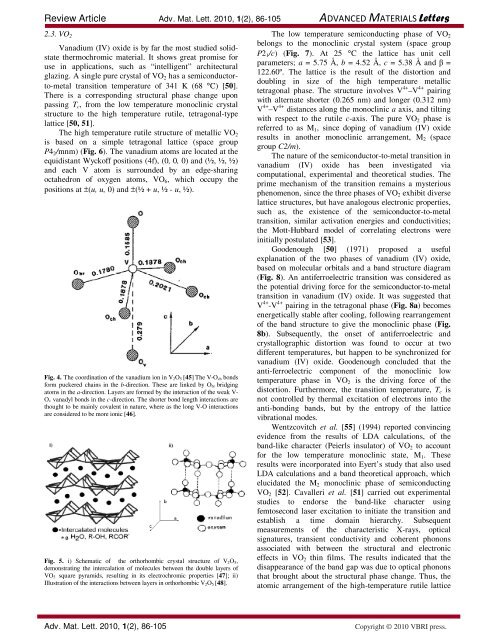Solid state thermochromic materials - Advanced Materials Letters
Solid state thermochromic materials - Advanced Materials Letters
Solid state thermochromic materials - Advanced Materials Letters
Create successful ePaper yourself
Turn your PDF publications into a flip-book with our unique Google optimized e-Paper software.
Review Article Adv. Mat. Lett. 2010, 1(2), 86-105 ADVANCED MATERIALS <strong>Letters</strong><br />
2.3. VO2<br />
Vanadium (IV) oxide is by far the most studied solid<strong>state</strong><br />
<strong>thermochromic</strong> material. It shows great promise for<br />
use in applications, such as “intelligent” architectural<br />
glazing. A single pure crystal of VO2 has a semiconductorto-metal<br />
transition temperature of 341 K (68 °C) [50].<br />
There is a corresponding structural phase change upon<br />
passing Tc, from the low temperature monoclinic crystal<br />
structure to the high temperature rutile, tetragonal-type<br />
lattice [50, 51].<br />
The high temperature rutile structure of metallic VO2<br />
is based on a simple tetragonal lattice (space group<br />
P42/mnm) (Fig. 6). The vanadium atoms are located at the<br />
equidistant Wyckoff positions (4f), (0, 0, 0) and (½, ½, ½)<br />
and each V atom is surrounded by an edge-sharing<br />
octahedron of oxygen atoms, VO6, which occupy the<br />
positions at ±(u, u, 0) and ±(½ + u, ½ - u, ½).<br />
Fig. 4. The coordination of the vanadium ion in V2O5 [45] The V-Och bonds<br />
form puckered chains in the b-direction. These are linked by Obr bridging<br />
atoms in the a-direction. Layers are formed by the interaction of the weak V-<br />
Ov vanadyl bonds in the c-direction. The shorter bond length interactions are<br />
thought to be mainly covalent in nature, where as the long V-O interactions<br />
are considered to be more ionic [46].<br />
Fig. 5. i) Schematic of the orthorhombic crystal structure of V2O5,<br />
demonstrating the intercalation of molecules between the double layers of<br />
VO5 square pyramids, resulting in its electrochromic properties [47]; ii)<br />
Illustration of the interactions between layers in orthorhombic V2O5 [48].<br />
The low temperature semiconducting phase of VO2<br />
belongs to the monoclinic crystal system (space group<br />
P21/c) (Fig. 7). At 25 °C the lattice has unit cell<br />
parameters; a = 5.75 Å, b = 4.52 Å, c = 5.38 Å and β =<br />
122.60º. The lattice is the result of the distortion and<br />
doubling in size of the high temperature metallic<br />
tetragonal phase. The structure involves V 4+ –V 4+ pairing<br />
with alternate shorter (0.265 nm) and longer (0.312 nm)<br />
V 4+ –V 4+ distances along the monoclinic a axis, and tilting<br />
with respect to the rutile c-axis. The pure VO2 phase is<br />
referred to as M1, since doping of vanadium (IV) oxide<br />
results in another monoclinic arrangement, M2 (space<br />
group C2/m).<br />
The nature of the semiconductor-to-metal transition in<br />
vanadium (IV) oxide has been investigated via<br />
computational, experimental and theoretical studies. The<br />
prime mechanism of the transition remains a mysterious<br />
phenomenon, since the three phases of VO2 exhibit diverse<br />
lattice structures, but have analogous electronic properties,<br />
such as, the existence of the semiconductor-to-metal<br />
transition, similar activation energies and conductivities;<br />
the Mott-Hubbard model of correlating electrons were<br />
initially postulated [53].<br />
Goodenough [50] (1971) proposed a useful<br />
explanation of the two phases of vanadium (IV) oxide,<br />
based on molecular orbitals and a band structure diagram<br />
(Fig. 8). An antiferroelectric transition was considered as<br />
the potential driving force for the semiconductor-to-metal<br />
transition in vanadium (IV) oxide. It was suggested that<br />
V 4+ -V 4+ pairing in the tetragonal phase (Fig. 8a) becomes<br />
energetically stable after cooling, following rearrangement<br />
of the band structure to give the monoclinic phase (Fig.<br />
8b). Subsequently, the onset of antiferroelectric and<br />
crystallographic distortion was found to occur at two<br />
different temperatures, but happen to be synchronized for<br />
vanadium (IV) oxide. Goodenough concluded that the<br />
anti-ferroelectric component of the monoclinic low<br />
temperature phase in VO2 is the driving force of the<br />
distortion. Furthermore, the transition temperature, Tc is<br />
not controlled by thermal excitation of electrons into the<br />
anti-bonding bands, but by the entropy of the lattice<br />
vibrational modes.<br />
Wentzcovitch et al. [55] (1994) reported convincing<br />
evidence from the results of LDA calculations, of the<br />
band-like character (Peierls insulator) of VO2 to account<br />
for the low temperature monoclinic <strong>state</strong>, M1. These<br />
results were incorporated into Eyert’s study that also used<br />
LDA calculations and a band theoretical approach, which<br />
elucidated the M2 monoclinic phase of semiconducting<br />
VO2 [52]. Cavalleri et al. [51] carried out experimental<br />
studies to endorse the band-like character using<br />
femtosecond laser excitation to initiate the transition and<br />
establish a time domain hierarchy. Subsequent<br />
measurements of the characteristic X-rays, optical<br />
signatures, transient conductivity and coherent phonons<br />
associated with between the structural and electronic<br />
effects in VO2 thin films. The results indicated that the<br />
disappearance of the band gap was due to optical phonons<br />
that brought about the structural phase change. Thus, the<br />
atomic arrangement of the high-temperature rutile lattice<br />
Adv. Mat. Lett. 2010, 1(2), 86-105 Copyright © 2010 VBRI press.
















